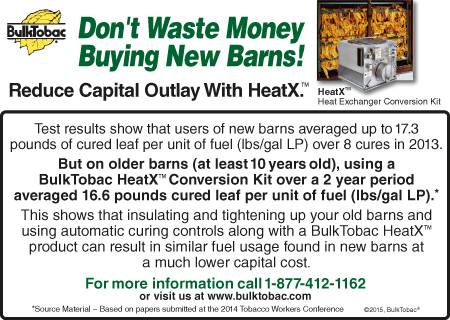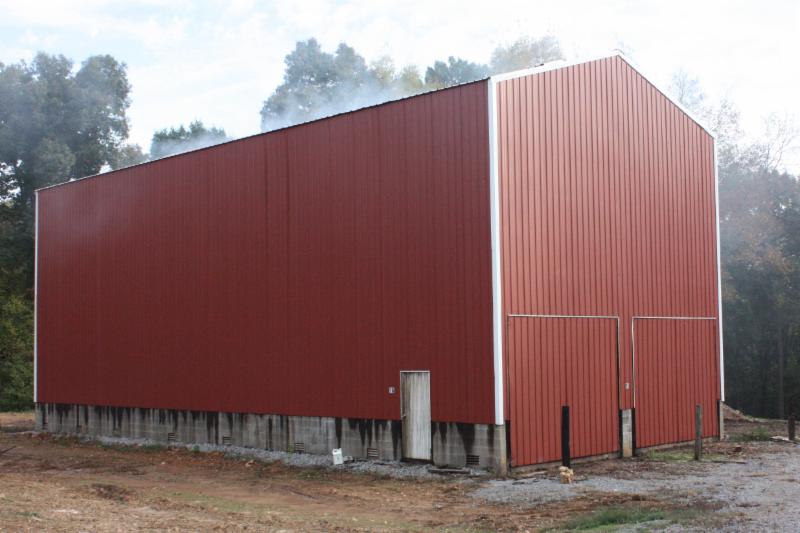Could fire-cured tobacco production be on the way to extinction? Dark fire-cured tobacco is facing a serious potential challenge from a proposal made last year by the Food and Drug Administration to limit levels of NNN, a tobacco-specific nitrosamine (TSNA), to no more than 1 ppm in finished smokeless tobacco products. Although several production practices may influence NNN accumulation, the biggest factor by far is the weather during the curing season. "Generally, we see higher NNN in wetter curing seasons, and lower NNN in dryer curing seasons," says Andy Bailey, Extension tobacco specialist covering dark tobacco in Kentucky and Tennessee. "It is possible for a grower to do everything in his control and still see NNN levels above 1 ppm if a wet curing season occurs. We don't believe this proposed standard is achievable consistently every year with our current technology." For now, fire-cured growers should produce a crop that is as low in TSNAs as possible, says Bailey. Here are some tips on how to do that: possible for a grower to do everything in his control and still see NNN levels above 1 ppm if a wet curing season occurs. We don't believe this proposed standard is achievable consistently every year with our current technology." For now, fire-cured growers should produce a crop that is as low in TSNAs as possible, says Bailey. Here are some tips on how to do that:
- Don't harvest or house wet tobacco,
- Use plenty of ventilation while curing. Adding air through the tobacco with bottom ventilators should be a standard practice.
- Start firing within one week of housing..
- Keep curing temperatures no higher than 130 degrees for no more than four to five days, even during the drying stage.
- Nitrogen application has an effect on all this, but fire-cured growers in the Black Patch are already following the fertilization practices that could help.
- There will eventually be help from breeding, with several varieties with lower potential to produce NNN in the pipeline.
Final numbers on flue-cured: At 209,500 acres, harvested area of U.S. flue-cured was down slightly from 213,500 acres in 2016. Yield was estimated at 2,254 pounds per acre, over 200 pounds more than the 2016 yield of 2,021. Consequently, production in 2017 is forecast at 472,200 pounds, up from 431,450 pounds in 2016. acre, over 200 pounds more than the 2016 yield of 2,021. Consequently, production in 2017 is forecast at 472,200 pounds, up from 431,450 pounds in 2016.
Will there be too much burley ... again? Following a much smaller crop last year, African growers are increasing production, says Will Snell, Kentucky Extension tobacco economist. As predicted earlier, a global surplus is likely in the coming year. "Demand conditions for U.S. burley remain soft in the international market, with global cigarette consumption falling and ample, less expensive foreign burley supplies available to buyers," he says. "U.S. burley exports fell 24 percent in 2016 and are down more than 15 percent late in 2017."
The only visa program available for agricultural labor in crop season 2018 will be H-2A, says Rick Alexander, Executive Director, Agriculture Workforce Management Association. There has been much talk of a proposed H2C program, but it will not materialize in time for 2018, if ever. "A description of the H-2A program and all the required forms are on our website at www.awmalabor.com," he says. Alexander and Snell will be two of four featured speakers at the Burley Tobacco Growers Cooperative Association Annual Meeting in Lexington, Ky., on Thursday. Others will be Greg Harris, president, Council for Burley Tobacco, and Daniel Green, president, International Tobacco Growers Assn. The Council for Burley Tobacco Annual Meeting will take place at the same site Friday.
Funding for lighting upgrades: You may be able to obtain a grant of at least $1,500 up to a maximum of $500,000 toward renewable energy systems through USDA's Rural Energy for America Program (REAP). If you are a customer of Duke Energy, you may also be able to qualify for that company's Rebate program, which is designed to absorb up to 75 percent of the cost of qualifying lighting upgrades. Application should be made through Elite Lighting, which is cooperating with Duke Energy in this program. For a free energy assessment and more information, you can contact Natalie Pulley, Elite Lighting, at 919-369-3943 or natalie@elitelighting.com.
Finally, a note from the editor: One of my pastimes is collecting Native American handicrafts. Late last year, I attended a festival for tribes in North Carolina, and at one of the handicraft stands, I came across this little pottery turtle (photo). It is hand made of red and white clay b  y Senora Lynch of the Haliwa Sapponi tribe near War-renton, N.C. She had etched a stylized tobacco plant on the turtle's shell and in fact has it growing from a stylized ear of corn. Well, I found it very cheering: The little "tobacco turtle" seemed to speak of good fortune for our commodity in the coming year. Not surprisingly, the figurine is now in my possession. But Senora has plenty more, I am sure. For more information, contact her at (252) 257-5771 /jetndal@yahoo.com. y Senora Lynch of the Haliwa Sapponi tribe near War-renton, N.C. She had etched a stylized tobacco plant on the turtle's shell and in fact has it growing from a stylized ear of corn. Well, I found it very cheering: The little "tobacco turtle" seemed to speak of good fortune for our commodity in the coming year. Not surprisingly, the figurine is now in my possession. But Senora has plenty more, I am sure. For more information, contact her at (252) 257-5771 /jetndal@yahoo.com.
We hope you have enjoyed the January I issue of Tobacco Farmer Newsletter. If you haven't signed on to receive the newsletter regularly, please email me at chrisbickers@gmail.com.--Chris Bickers
GAP GROWER TRAINING EVENTS
Check with your local Extension Service office for further details.
All meetings listed here are free and presented in English.
- January 10, 9 a.m. Rocky Mount, N.C.
- January 11, 9 a.m. Smithfield, N.C.
- January 12, 9 a.m. Lexington, Ky. (in conjunction with Tobacco Expo).
- January 12, 9 a.m. Oxford, N.C.
- January 22, 9 a.m. Yanceyville, N.C.
- January 22, 6 p.m. Dixon, Ky.
- January 23, 9 a.m. Winston-Salem, N.C.
- January 23, 9 a.m. Blackstone, Va.
- January 23, 9:30 a.m. Dover, Tn.
- January 24, 9 a.m. Williamston, N.C.
- January 24, 4 p.m. South Hill, Va.
- January 25, 9 a.m. Greenville, N.C.
- January 25, 2 p.m. Clinton, N.C.
- January 25, 4 p.m. Chatham, Va.
- January 26, 9 a.m. Shelbyville, Ky.
- January 26, 9 a.m. Kinston, N.C.
- January 26, 1 p.m. New Castle, Ky.
- January 29, 9 a.m. Goldsboro, N.C.
- January 30, 9 a.m. Sanford, N.C.
- January 31, 10 a.m. Scottsburg, Va.
- February 1, 6 p.m. Stanford, Ky.
- February 2, 1:30 p.m. Raleigh, N.C. (in conjunction with Southern Farm Show).
- February 5, 9 a.m. Lillington, N.C.
- February 5, 4:30 p.m. Franklin, Ky.
- February 5, 6 p.m. Scottsville, Ky.
- February 6, 8:30 a.m. Springfield, Tn. (in conjunction with Kentucky-Tennessee Tobacco Expo).
- February 8, 5 p.m. Albany, Ky.
- February 8, 6 p.m. New Tazewell, Tn.
- February 13, 6 p.m. Athens, Tn.
- February 19, 12 p.m. Carthage, Tn.
- February 19, 6 p.m. Hartsville, Tn.
- February 20, 4:30 p.m. Clarksville, Tn.
- February 20, 6 p.m. Sharpsburg, Ky.
- February 21, 8:30 a.m. Lawrenceburg, Tn.
- February 22, 6 p.m. Maysville, Ky.
- February 26, 4 p.m. Central City, Ky.
- February 26, 6 p.m. Lafayette, Tn.
- February 26, 6 p.m. Bowling Green, Ky.
- March 1, 10 a.m. Campbridge City, In.
- March 6, 2:30 p.m. Mayfield, Ky.
- March 7, 6 p.m. Greeneville, Tn.
- March 12, 10:30 a.m. Tifton, Ga.
- March 13, 10:30 a.m. Marion, S.C.
- March 13, 1 p.m. Murray, Ky.
- March 20, 6:30 p.m. Glasgow, Ky.
- March 20, 6:30 p.m. Gray, Tn.
DATES TO REMEMBER
- January 11, 4 p.m. Burley Tobacco Growers Cooperative Association Annual Membership Meeting. Lexington, Ky. Convention Center, 4 p.m. (in conjunction with Tobacco Expo).
- January 12, 12 noon. Council for Burley Tobacco Annual Meeting. Lexington (Ky.) Convention Center (in conjunction with Tobacco Expo).
- January 15-18. Tobacco Workers' Conference. Hilton Myrtle Beach Resort, Myrtle Beach, S.C.
- January 17-18, 10 a.m. S.C. AgriBiz and Farm Expo Florence (S.C.) Civic Center at the junction of I-95 and I-20.
- January 31-February 2, 9 a.m. Southern Farm Show. N.C. State Fairgrounds, Raleigh, N.C.
- February 2, 10 a.m. Annual Meeting, Tobacco Growers Association of N.C., Holshouser Building, N.C. State Fairgrounds (in conjunction with Southern Farm Show). Meeting ends with lunch.
|


No comments:
Post a Comment
Note: Only a member of this blog may post a comment.